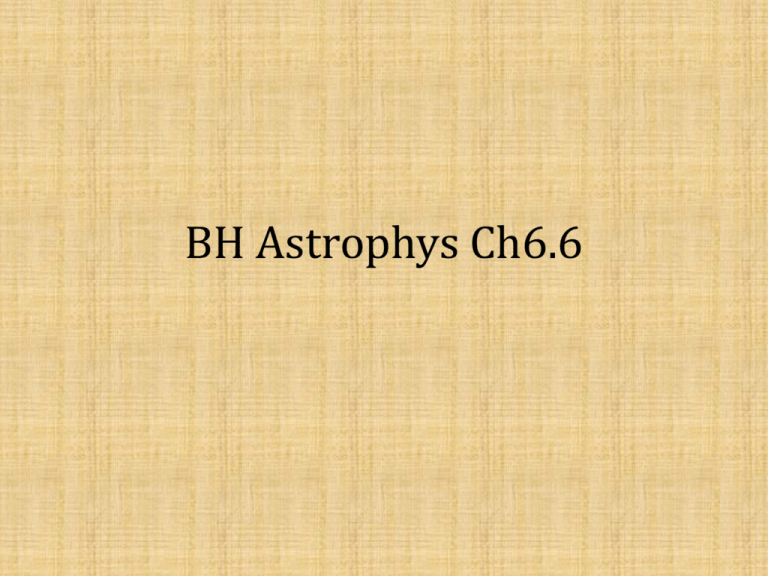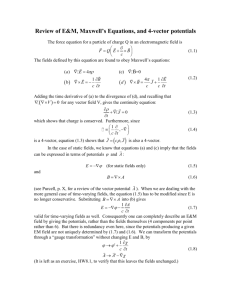PPT
advertisement

BH Astrophys Ch6.6 The Maxwell equations – how charges produce fields 𝛻·𝐵 =0 𝛻 · 𝐷 = 4𝜋𝜌 𝛻×𝐸 =− 1𝜕𝐵 𝑐 𝜕𝑡 4𝜋 1 𝜕𝐷 𝛻×𝐻 = 𝐽 + 𝑐 𝑐 𝜕𝑡 Total of 8 equations, but only 6 independent variables (3 components each for E,B) Where are the two extra equations hidden? Conservation of (electric) charge See Jackson 3ed Ch 6.11 for more about this “Constrained transport” of magnetic field Conservation of magnetic monopoles ( equal zero in our universe) Therefore the Maxwell equations actually have in-built conservation of electric and magnetic charges! (therefore total independent equations are 6 only) Energy momentum equations – How fields affect particles Work done by EM field on charges Lorentz force equation For fluids, they translate to Recall energy equation of fluid The scalar and vector potentials Given the Maxwell equations, and One can define a scalar potential 𝜙 and a vector potential 𝐴 which have the relations with 𝐸 and 𝐵 as 𝐵 =𝛻× 𝐴 𝐸 = −𝛻𝜙 − 1𝜕𝐴 𝑐 𝜕𝑡 However, we can see that any change of 𝜙 and 𝐴 that follow 𝜙′ = 𝜙 + 1 𝜕𝑍 𝑐 𝜕𝑡 ′ 𝐴 = 𝐴 + 𝛻𝑍 Will still give the same 𝐸 and 𝐵 fields This is called “gauge invariance”, we have the freedom to choose some Z that would make problems easier. The Lorenz Gauge Applying the definitions 𝐵 =𝛻×𝐴 𝐸 = −𝛻𝜙 − One can transform the two source equations 1𝜕𝐴 𝑐 𝜕𝑡 𝛻 · 𝐷 = 4𝜋𝜌 𝛻×𝐻 = 4𝜋 1 𝜕𝐷 𝐽 + 𝑐 𝑐 𝜕𝑡 into Often when the problem involves waves, a convenient gauge is the “Lotenz Gauge” 1 𝜕𝜙 𝛻· 𝐴 + = 0 Which, through 𝑐 𝜕𝑡 𝜙′ = 𝜙 + ′ 1 𝜕𝑍 𝑐 𝜕𝑡 also tells us that 𝐴 = 𝐴 + 𝛻𝑍 1 𝜕2𝑍 − 2 2 + 𝛻 2𝑍 = 0 𝑐 𝜕𝑡 Applying the Lorenz Gauge condition, the two potential equations become 1 𝜕2𝜙 − 𝛻 2 𝜙 = 4𝜋𝜌 2 2 𝑐 𝜕𝑡 1 𝜕2 𝐴 4𝜋 2 𝐴 = − 𝛻 𝐽 𝑐 2 𝜕𝑡 2 𝑐 This is not the Lorentz as in Lorentz transformations! Ludvig Lorenz (1829~1891) Hendrik Lorentz (1853~1928) Linearly polarized plane EM waves in vacuum In vacuum, the wave equations become 1 𝜕2𝜙 − 𝛻 2𝜙 = 0 2 2 𝑐 𝜕𝑡 1 𝜕2 𝐴 4𝜋 2 − 𝛻 𝐴 = 𝐽 𝑐 2 𝜕𝑡 2 𝑐 Which gives The Lotenz gauge condition 1 𝜕𝜙 𝛻· 𝐴 + =0 𝑐 𝜕𝑡 Since Z used in the gauge transforms also satisfies It also has the wave solution 𝜙′ = 𝜙 + ′ 1 𝜕𝑍 𝑐 𝜕𝑡 𝐴 = 𝐴 + 𝛻𝑍 Then tells us that gives 1 𝜕2𝑍 − 2 2 + 𝛻 2𝑍 = 0 𝑐 𝜕𝑡 Building the spacetime compatible form of electromagnetism To work in spacetime, we need equations to be in tensor form such that they will be valid in any frame, in harmony with the principle of relativity. It is therefore crucial to rewrite the whole set of equations in 4-form, either with 4vectors or tensors. Previously, we started off with the electric and magnetic fields from the Maxwell’s equations and finally came to another fully equivalent form in describing things – the potentials. Here, we will do the reverse, we work out the potential in 4-form then find some suitable tensor to fit in the electric and magnetic fields. The current 4-vector Recall the charge continuity equation 𝜕𝜌 +𝛻· 𝐽 =0 𝜕𝑡 Observing closely, we see that if we define 𝐽𝜇 = 𝜌, 𝐽 , then using 𝑥 𝜇 = 𝑡, 𝑥, 𝑦, 𝑧 , the continuity equation can very simply be written as 𝜕𝐽𝜇 ≡ 𝐽𝜇 ,𝜇 = 𝜕𝜇 𝐽𝜇 = 0 𝜇 𝜕𝑥 (contracting a vector and a one-form gives a scalar) What this says is that 𝐽𝜇 is the correct 4-vector that compatible with space-time transforms! Note: 𝜕 𝜕 𝜕 𝜕 𝜕 𝜕𝜇 ≡ 𝜇 = , , , 𝜕𝑥 𝜕𝑡 𝜕𝑥 𝜕𝑦 𝜕𝑧 𝜕𝜇 ≡ 𝜕 𝜕 𝜕 𝜕 𝜕 = − , , , 𝜕𝑥𝜇 𝜕𝑡 𝜕𝑥 𝜕𝑦 𝜕𝑧 The potential 4-vector Recall the wave equations 1 𝜕2𝜙 2 𝜙 = 4𝜋𝜌 − 𝛻 𝑐 2 𝜕𝑡 2 We can see that in both cases we have the operator 𝜕2 𝜕𝑡 2 1 𝜕2 𝐴 4𝜋 2 −𝛻 𝐴 = 𝐽 𝑐 2 𝜕𝑡 2 𝑐 − 𝛻 2 acting on either 𝜙 or 𝐴 . Is that operator also related to some 4-vector? Apparently, Yes! It is the square of the gradient operator! 2 𝜕 𝜕𝜇 𝜕𝜇 = −( 2 − 𝛻 2 ) 𝜕𝑡 Then, since 𝐽𝜇 = 𝜌, 𝐽 is a 4-vector as we have demonstrated, we can also define the 4-potential 𝐴𝜇 ≡ 𝜙, 𝐴 Then, the wave equations are simply, in 4-form, 𝜕 𝛼 𝜕𝛼 𝐴𝛽 = −4𝜋𝐽𝛽 And the Lorenz gauge condition 𝐴𝛼 ,𝛼 = 0 Reminder: 𝛻 · 𝐴 + 1 𝜕𝜙 𝑐 𝜕𝑡 =0 Gauge-free form Recall that before we took the Lorenz gauge, our equations for the potentials looked like: By applying the definitions 𝐽𝜇 = 𝜌, 𝐽 ; 𝐴𝜇 We find the 4-form for the above 2 equations as ≡ 𝜙, 𝐴 ; 𝜕𝜇 𝜕𝜇 = (𝛻 2 − 𝜕2 ) 𝜕𝑡 2 𝜕 𝛼 𝜕𝛼 𝐴𝛽 − 𝜕𝛽 𝜕𝛼 𝐴𝛼 = −4𝜋𝐽𝛽 Since the equations for the potentials originally came from 𝛻 · 𝐷 = 4𝜋𝜌 𝛻×𝐻− 1 𝜕 𝐷 4𝜋 = 𝐽 𝑐 𝜕𝑡 𝑐 We should be able to manipulate 𝜕 𝛼 𝜕𝛼 𝐴𝛽 − 𝜕𝛽 𝜕𝛼 𝐴𝛼 = −4𝜋𝐽𝛽 into something that gives us the Maxwell equations in terms of E and B fields Towards the Maxwell equations Lets rewrite 𝜕 𝛼 𝜕𝛼 𝐴𝛽 − 𝜕𝛽 𝜕𝛼 𝐴𝛼 = −4𝜋𝐽𝛽 as 𝜕𝛼 (𝜕 𝛼 𝐴𝛽 − 𝜕𝛽 𝐴𝛼 ) = −4𝜋𝐽𝛽 Comparing with 𝛻 · 𝐷 = 4𝜋𝜌 𝛻×𝐻− 1 𝜕 𝐷 4𝜋 = 𝐽 𝑐 𝜕𝑡 𝑐 It should be clear that as the Maxwell equations contain only 1st derivatives, 𝜕 𝛼 𝐴𝛽 − 𝜕𝛽 𝐴𝛼 should be some 2nd rank tensor that contains that E and B fields. 𝐹 αβ ≡ 𝜕 𝛼 𝐴𝛽 − 𝜕𝛽 𝐴𝛼 𝐹 αβ = 0 = 0 𝜕 0 𝐴1 − 𝜕 1 𝐴0 𝜕 0 𝐴2 − 𝜕 2 𝐴0 𝜕 0 𝐴3 − 𝜕 3 𝐴0 1 0 1 2 2 1 − 𝜕 𝐴 −𝜕 𝐴 0 𝜕 𝐴 −𝜕 𝐴 𝜕1 𝐴3 − 𝜕 3 𝐴1 − 𝜕 0 𝐴2 − 𝜕 2 𝐴0 − 𝜕1 𝐴2 − 𝜕 2 𝐴1 0 𝜕 2 𝐴3 − 𝜕 3 𝐴2 − 𝜕 0 𝐴3 − 𝜕 3 𝐴0 − 𝜕1 𝐴3 − 𝜕 3 𝐴1 − 𝜕 2 𝐴3 − 𝜕 3 𝐴2 0 𝜕𝐴𝑦 𝜕𝜙 𝜕𝐴𝑥 𝜕𝜙 𝜕𝐴𝑧 𝜕𝜙 − − − − − − 𝜕𝑡 𝜕𝑥 𝜕𝑡 𝜕𝑦 𝜕𝑡 𝜕𝑧 0 𝐸𝑥 𝐸𝑦 𝐸𝑧 𝜕𝐴𝑦 𝜕𝐴𝑥 𝜕𝐴𝑧 𝜕𝐴𝑥 −𝐸𝑥 0 𝐵𝑧 −𝐵𝑦 0 − − = 𝜕𝑥 𝜕𝑦 𝜕𝑥 𝜕𝑧 −𝐸𝑦 −𝐵𝑧 0 𝐵𝑥 𝜕𝐴𝑧 𝜕𝐴𝑦 −𝐸𝑧 𝐵𝑦 −𝐵𝑥 0 0 − 𝜕𝑦 𝜕𝑧 1𝜕𝐴 𝐵 =𝛻×𝐴 0 𝐸 = −𝛻𝜙 − 𝑐 𝜕𝑡 0 1 The Maxwell’s equations in 4-form As we defined the Minkowski metric as 𝜂αβ = −1 0 0 0 0 1 0 0 0 0 1 0 0 0 0 1 Same in Griffiths, Introduction to Electrodynamics 3ed the Faraday tensor has the form we derived 𝐹 αβ ≡ 𝜕 𝛼 𝐴𝛽 − 𝜕𝛽 𝐴𝛼 = 0 −𝐸𝑥 −𝐸𝑦 −𝐸𝑧 𝐸𝑥 0 −𝐵𝑧 𝐵𝑦 𝐸𝑦 𝐵𝑧 0 −𝐵𝑥 𝐸𝑧 −𝐵𝑦 𝐵𝑥 0 and 𝐹αβ ≡ 0 𝐸𝑥 𝐸𝑦 𝐸𝑧 −𝐸𝑥 0 −𝐵𝑧 𝐵𝑦 −𝐸𝑦 𝐵𝑧 0 −𝐵𝑥 −𝐸𝑧 −𝐵𝑦 𝐵𝑥 0 The source equation 𝜕𝛼 (𝜕 𝛼 𝐴𝛽 − 𝜕𝛽 𝐴𝛼 ) = −4𝜋𝐽𝛽 then becomes 𝜕𝛼 𝐹 αβ = −4𝜋𝐽𝛽 Or, since 𝐹 αβ = −𝐹 βα (2nd rank anti-symmetric tensor), 𝜕𝛼 𝐹 βα = 4𝜋𝐽𝛽 → 𝜕β 𝐹 αβ = 4𝜋𝐽α The Maxwell’s equations in 4-form (cont’) Also, we can define another 2nd rank tensor (sometimes called the Maxwell tensor) 𝐵 =𝛻×𝐴 𝐸 = −𝛻𝜙 − 1𝜕𝐴 𝑐 𝜕𝑡 𝐺 αβ ≡ 𝐵𝑥 0 𝐸𝑧 −𝐸𝑦 𝐵𝑦 −𝐸𝑧 0 𝐸𝑥 𝐵𝑧 𝐸𝑦 −𝐸𝑥 0 Can also be expressed as 𝜕𝛽 𝐺 αβ = 0 𝐹 αβ ≡ Faraday tensor Note that in Jackson, one finds 0 −𝐵𝑥 −𝐵𝑦 −𝐵𝑧 𝐹 αβ ≡ 0 𝐸𝑥 𝐸𝑦 𝐸𝑧 −𝐸𝑥 0 𝐵𝑧 −𝐵𝑦 This is because Jackson uses the metric −𝐸𝑦 −𝐵𝑧 0 𝐵𝑥 𝜂αβ = −𝐸𝑧 𝐵𝑦 −𝐵𝑥 0 0 −𝐸𝑥 −𝐸𝑦 −𝐸𝑧 𝐸𝑥 0 −𝐵𝑧 𝐵𝑦 𝐸𝑦 𝐵𝑧 0 −𝐵𝑥 𝐸𝑧 −𝐵𝑦 𝐵𝑥 0 Different by a minus sign 1 0 0 0 −1 0 0 0 −1 0 0 0 0 0 0 −1 Looking at page 11 where we derived the Faraday tensor will show why. The Maxwell’s equations in 4-form (cont’) We can also show that 𝜕𝛽 𝐺 αβ = 0 can be written as 𝜕𝛼 𝐹βγ + 𝜕𝛽 𝐹γα + 𝜕𝛾 𝐹αβ = 0 which basically is just an identity. This means that by defining 𝐹 αβ ≡ 𝜕 𝛼 𝐴𝛽 − 𝜕𝛽 𝐴𝛼 we have already included the homogeneous Maxwell equations. 4-force Previously, we have defined the equations 𝑈 𝛼 ≡ Now, compare 𝐹 αβ = 0 −𝐸𝑥 −𝐸𝑦 −𝐸𝑧 𝐸𝑥 0 −𝐵𝑧 𝐵𝑦 𝐸𝑦 𝐵𝑧 0 −𝐵𝑥 dx𝛼 ; dτ 𝑃 𝛼 ≡ 𝑚0 𝑈 𝛼 ; 𝐹 α = dPα dτ 𝐸𝑧 −𝐵𝑦 𝐵𝑥 0 Then one can see that what is left to write out the electromagnetic 4-force is 𝑈 𝛼 Thus, dP α 𝑞 αβ = 𝐹 𝑈𝛽 dτ 𝑐 Simultaneously contains the work done by the E field and the Lorenz force. Equation 6.116 is wrong!! It should be the one-form 4-velocity Plane EM waves in 4-form Previously, we found that in the Lorenz gauge 𝜕 𝛼 𝜕𝛼 𝐴𝛽 = −4𝜋𝐽𝛽 , Therefore the source free equation is 𝜕 𝛼 𝜕𝛼 𝐴𝛽 = 0, which has the solution We see that the phase term 𝑘 · 𝑥 = −ωt + 𝑘𝑥 𝑥 + 𝑘𝑦 𝑦 + 𝑘𝑧 𝑧 Then, since phase is also a scalar, (sorry I don’t have a very good explanation for this), we can rewrite 𝑘 · 𝑥 = −ωt + 𝑘𝑥 𝑥 + 𝑘𝑦 𝑦 + 𝑘𝑧 𝑧 = 𝜂αβ 𝑘 𝛼 𝑥 𝛽 𝑘 𝛼 = 𝜔, 𝑘 𝜕 𝛼 𝜕𝛼 𝐴𝛽 = 0 then gives 𝜂αβ 𝑘 𝛼 𝑘𝛽 = −𝜔2 + 𝑘 2 = 0 → photons travel along null vectors Fluid aspects next week






